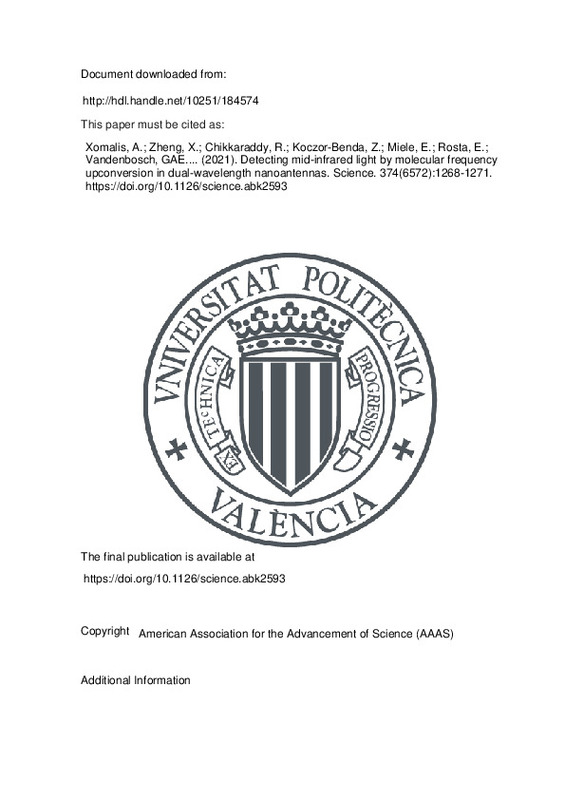JavaScript is disabled for your browser. Some features of this site may not work without it.
Buscar en RiuNet
Listar
Mi cuenta
Estadísticas
Ayuda RiuNet
Admin. UPV
Detecting mid-infrared light by molecular frequency upconversion in dual-wavelength nanoantennas
Mostrar el registro sencillo del ítem
Ficheros en el ítem
| dc.contributor.author | Xomalis, Angelos
|
es_ES |
| dc.contributor.author | Zheng, Xuezhi
|
es_ES |
| dc.contributor.author | Chikkaraddy, Rohit
|
es_ES |
| dc.contributor.author | Koczor-Benda, Zsuzsanna
|
es_ES |
| dc.contributor.author | Miele, Ermanno
|
es_ES |
| dc.contributor.author | Rosta, Edina
|
es_ES |
| dc.contributor.author | Vandenbosch, Guy A. E.
|
es_ES |
| dc.contributor.author | Martínez Abietar, Alejandro José
|
es_ES |
| dc.contributor.author | Baumberg, Jeremy J.
|
es_ES |
| dc.date.accessioned | 2022-07-20T18:06:09Z | |
| dc.date.available | 2022-07-20T18:06:09Z | |
| dc.date.issued | 2021-12-03 | es_ES |
| dc.identifier.issn | 0036-8075 | es_ES |
| dc.identifier.uri | http://hdl.handle.net/10251/184574 | |
| dc.description.abstract | [EN] Coherent interconversion of signals between optical and mechanical domains is enabled by optomechanical interactions. Extreme light-matter coupling produced by confining light to nanoscale mode volumes can then access single mid-infrared (MIR) photon sensitivity. Here, we used the infrared absorption and Raman activity of molecular vibrations in plasmonic nanocavities to demonstrate frequency upconversion. We converted approximately 10-micrometer-wavelength incoming light to visible light by surface-enhanced Raman scattering (SERS) in doubly resonant antennas that enhanced upconversion by more than 10(10). We showed 140% amplification of the SERS anti-Stokes emission when an MIR pump was tuned to a molecular vibrational frequency, obtaining lowest detectable powers of 1 to 10 microwatts per square micrometer at room temperature. These results have potential for low-cost and large-scale infrared detectors and spectroscopic techniques. | es_ES |
| dc.description.sponsorship | This work was supported by the European Union's Horizon 2020 Research and Innovation Program under grant agreements 829067 (THOR), 861950 (POSEIDON), and 883703 (PICOFORCE) and by the Engineering and Physical Sciences Research Council (EPSRC) (Cambridge NanoDTC grants EP/L015978/1, EP/L027151/1, EP/S022953/1, EP/P029426/1, and EP/R020965/1). X.Z. acknowledges support from KU Leuven Internal Funds C14/19/083, IDN/20/014, KA/20/019, and FWO G090017N. R.C. acknowledges support from Trinity College, University of Cambridge. Z.K.B. and E.R. acknowledge funding from the EPSRC (EP/R013012/1, EP/L027151/1) and ERC project 757850 BioNet. We are grateful to the UK Materials and Molecular Modelling Hub, which is partially funded by EPSRC (EP/P020194/1), for computational resources. | es_ES |
| dc.language | Inglés | es_ES |
| dc.publisher | American Association for the Advancement of Science (AAAS) | es_ES |
| dc.relation.ispartof | Science | es_ES |
| dc.rights | Reserva de todos los derechos | es_ES |
| dc.subject.classification | TEORIA DE LA SEÑAL Y COMUNICACIONES | es_ES |
| dc.title | Detecting mid-infrared light by molecular frequency upconversion in dual-wavelength nanoantennas | es_ES |
| dc.type | Artículo | es_ES |
| dc.identifier.doi | 10.1126/science.abk2593 | es_ES |
| dc.relation.projectID | info:eu-repo/grantAgreement/EC/H2020/757850/EU | es_ES |
| dc.relation.projectID | info:eu-repo/grantAgreement/EPSRC//EP%2FL015978%2F1/ | es_ES |
| dc.relation.projectID | info:eu-repo/grantAgreement/EC/H2020/829067/EU | es_ES |
| dc.relation.projectID | info:eu-repo/grantAgreement/EPSRC//EP%2FL027151%2F1/ | es_ES |
| dc.relation.projectID | info:eu-repo/grantAgreement/EC/H2020/861950/EU | es_ES |
| dc.relation.projectID | info:eu-repo/grantAgreement/EPSRC//EP%2FS022953%2F1/ | es_ES |
| dc.relation.projectID | info:eu-repo/grantAgreement/EC/H2020/883703/EU | es_ES |
| dc.relation.projectID | info:eu-repo/grantAgreement/EPSRC//EP%2FP029426%2F1/ | es_ES |
| dc.relation.projectID | info:eu-repo/grantAgreement/EPSRC//EP%2FR020965%2F1/ | es_ES |
| dc.relation.projectID | info:eu-repo/grantAgreement/KU Leuven//C14%2F19%2F083/ | es_ES |
| dc.relation.projectID | info:eu-repo/grantAgreement/KU Leuven//IDN%2F20%2F014/ | es_ES |
| dc.relation.projectID | info:eu-repo/grantAgreement/KU Leuven//KA%2F20%2F019/ | es_ES |
| dc.relation.projectID | info:eu-repo/grantAgreement/FWO//G090017N/ | es_ES |
| dc.relation.projectID | info:eu-repo/grantAgreement/EPSRC//EP%2FR013012%2F1/ | es_ES |
| dc.relation.projectID | info:eu-repo/grantAgreement/EPSRC//EP%2FP020194%2F1/ | es_ES |
| dc.relation.projectID | info:eu-repo/grantAgreement/GENERALITAT VALENCIANA//APE%2F2018%2FA%2F010//TERAHERTZ DETECTION ENABLED BY MOLECULAR OPTOMECHANICS (THOR)/ | es_ES |
| dc.rights.accessRights | Abierto | es_ES |
| dc.contributor.affiliation | Universitat Politècnica de València. Departamento de Comunicaciones - Departament de Comunicacions | es_ES |
| dc.description.bibliographicCitation | Xomalis, A.; Zheng, X.; Chikkaraddy, R.; Koczor-Benda, Z.; Miele, E.; Rosta, E.; Vandenbosch, GAE.... (2021). Detecting mid-infrared light by molecular frequency upconversion in dual-wavelength nanoantennas. Science. 374(6572):1268-1271. https://doi.org/10.1126/science.abk2593 | es_ES |
| dc.description.accrualMethod | S | es_ES |
| dc.relation.publisherversion | https://doi.org/10.1126/science.abk2593 | es_ES |
| dc.description.upvformatpinicio | 1268 | es_ES |
| dc.description.upvformatpfin | 1271 | es_ES |
| dc.type.version | info:eu-repo/semantics/publishedVersion | es_ES |
| dc.description.volume | 374 | es_ES |
| dc.description.issue | 6572 | es_ES |
| dc.identifier.pmid | 34855505 | es_ES |
| dc.relation.pasarela | S\453479 | es_ES |
| dc.contributor.funder | KU Leuven | es_ES |
| dc.contributor.funder | European Commission | es_ES |
| dc.contributor.funder | GENERALITAT VALENCIANA | es_ES |
| dc.contributor.funder | University of Cambridge | es_ES |
| dc.contributor.funder | Research Foundation Flanders | es_ES |
| dc.contributor.funder | COMISION DE LAS COMUNIDADES EUROPEA | es_ES |
| dc.contributor.funder | Engineering and Physical Sciences Research Council, Reino Unido | es_ES |







![[Cerrado]](/themes/UPV/images/candado.png)

